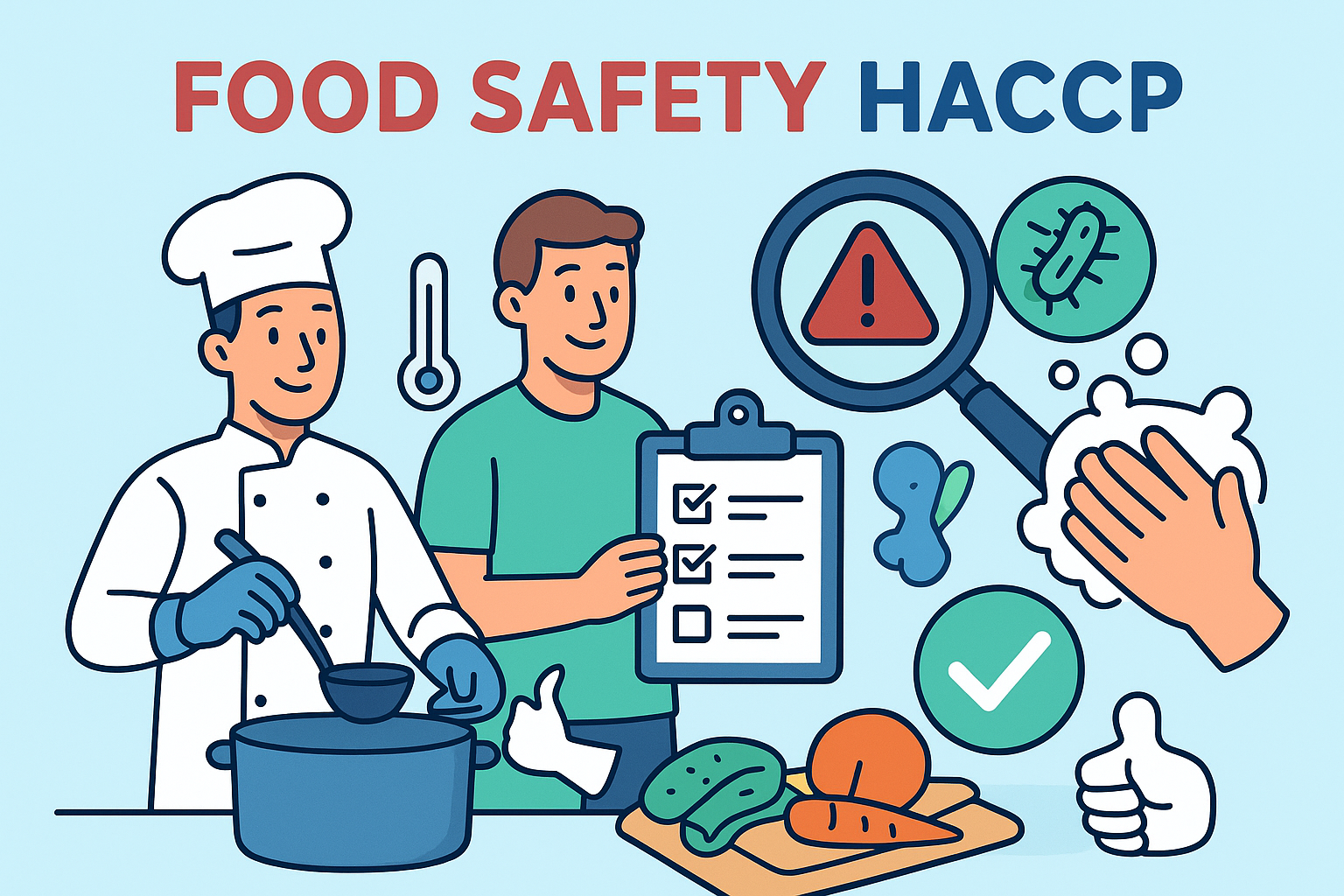
Food safety is one of the most critical aspects of working on board luxury yachts. Guests expect not only high-quality service but also meals that are safe, hygienic, and compliant with international standards. To achieve this, yacht crew—especially those working in the galley and service departments—must understand and apply HACCP (Hazard Analysis and Critical Control Points).
HACCP is a globally recognized system designed to identify, evaluate, and control hazards that can compromise food safety. Originally developed for NASA to ensure astronaut meals were safe during space missions, HACCP is now the gold standard in the food industry worldwide, including the luxury yachting sector.
1. What is HACCP?
HACCP is a preventive food safety management system that focuses on anticipating and eliminating potential hazards before they occur. Unlike traditional methods that relied heavily on testing end products, HACCP emphasizes controlling processes and establishing strict monitoring at critical points of food preparation.
On yachts, where food is often prepared in limited spaces and stored for long journeys, HACCP becomes essential to prevent foodborne illnesses that could endanger guests and crew.
2. Types of Hazards in Food Safety
HACCP identifies three main categories of hazards:
-
Biological Hazards – Bacteria (e.g., Salmonella, E. coli, Listeria), viruses (e.g., Norovirus, Hepatitis A), and parasites. These can cause serious foodborne diseases if not controlled.
-
Chemical Hazards – Residues from cleaning agents, pesticides, or contamination from packaging materials.
-
Physical Hazards – Foreign objects such as glass shards, metal fragments, or plastic pieces that accidentally enter food during preparation.
Understanding these hazards helps yacht crew apply appropriate preventive measures.
3. The Seven Principles of HACCP
The HACCP system is built on seven key principles that guide food safety management:
-
Conduct Hazard Analysis
-
Identify potential biological, chemical, and physical hazards in each stage of food handling—from receiving supplies to serving meals.
-
Example: Raw seafood may carry harmful bacteria; cleaning chemicals may contaminate food if improperly stored.
-
-
Identify Critical Control Points (CCPs)
-
CCPs are stages where hazards can be prevented, eliminated, or reduced to safe levels.
-
Example: Cooking chicken at 75°C to kill Salmonella.
-
-
Establish Critical Limits
-
Set measurable standards (time, temperature, pH level) that must be achieved at each CCP.
-
Example: Cold storage must be maintained below 5°C.
-
-
Establish Monitoring Procedures
-
Develop methods to regularly check CCPs.
-
Example: Use thermometers to verify cooking temperatures and log them daily.
-
-
Establish Corrective Actions
-
Define steps to take when monitoring shows a deviation from critical limits.
-
Example: If a refrigerator is above 5°C, move perishable food to another cooler and repair the unit.
-
-
Establish Verification Procedures
-
Confirm that the HACCP system is working effectively through audits, inspections, and testing.
-
-
Establish Documentation and Record-Keeping
-
Keep written records of hazard analyses, monitoring logs, corrective actions, and verification results.
-
This documentation is crucial for compliance with maritime health inspections.
-
4. HACCP Implementation on Yachts
Applying HACCP principles on a yacht requires adjustments to the unique environment of marine operations:
-
Provisioning and Storage
-
All supplies must come from certified providers. Food should be inspected upon delivery, checking temperature, packaging integrity, and expiration dates.
-
Freezers and refrigerators must be monitored daily to maintain safe storage conditions.
-
-
Preparation and Cooking
-
Strict separation of raw and cooked food is necessary to prevent cross-contamination.
-
Color-coded cutting boards and utensils should be used.
-
Cooking must reach prescribed critical temperatures, verified with calibrated thermometers.
-
-
Cleaning and Hygiene
-
Crew must follow proper handwashing procedures and wear protective clothing such as gloves and hairnets.
-
Surfaces, equipment, and utensils should be sanitized regularly.
-
-
Waste Management
-
Waste should be separated, sealed, and disposed of according to maritime regulations to avoid contamination.
-
5. The Role of Crew Training
Even the most detailed HACCP plan is useless without proper training. Every crew member involved in food handling must be familiar with HACCP principles. A yacht training course focusing on food safety and hygiene helps ensure that:
-
Crew members recognize foodborne hazards.
-
They understand proper temperature controls and sanitation practices.
-
They can document and monitor HACCP procedures accurately.
Training also prepares crew to pass health inspections conducted in ports, which are increasingly strict under international maritime law.
6. Benefits of HACCP in Yachting
Implementing HACCP brings several key benefits:
-
Guest Safety: Prevents foodborne illnesses, protecting the yacht’s reputation.
-
Compliance: Meets international maritime health and safety regulations.
-
Efficiency: Streamlined processes reduce food waste and errors.
-
Crew Confidence: Trained crew members perform with greater professionalism.
-
Luxury Standard: Guests on yachts expect not only luxury but also safety and trust in every meal served.
Conclusion
Food safety is a non-negotiable aspect of yacht operations. By applying HACCP principles, yachts can guarantee that every meal served meets the highest international standards of hygiene and safety. Crew members trained in HACCP not only safeguard guest health but also strengthen their professional standing in the global yachting industry.
In the end, HACCP is more than just a regulatory requirement—it is a commitment to excellence, professionalism, and care for both guests and crew. For anyone pursuing a career in luxury yachting, mastering food safety HACCP through a professional yacht crew training course is an essential step toward success.
